Ten Years After Lampedusa: Why Can’t Europe Find an Answer to the Deaths?
The night is moonless and full of stars as the overcrowded fishing trawler approaches the coast of the Italian island of Lampedusa. Less than a kilometre away, the lights of the port can be seen. “We were happy,” one of the passengers will say later. “We thought we’d arrived,” another will say.
Then the engine stops. Silence. The ship is unable to manoeuvre, unable to reach the island under its own power.
A fishing boat approaches. It goes around the trawler and then continues to Lampedusa to unload its fresh catch. The crew will later claim that they did not hear the cries or notice the distress.
A second boat approaches. It too turns away.
About two hours pass. The captain of the trawler, a Tunisian smuggler, soaks a cloth in petrol and sets it on fire. He would later tell investigators that he wanted to make the boat visible. But the flames spread to the foredeck, where fuel had leaked. And so, on 3 October 2013, one of the worst maritime disasters in the Mediterranean since the Second World War unfolded. This report reconstructs it through investigation files, court reports and eyewitness accounts.
At least 520 people were crammed into the 18-metre trawler. Many were in the hold, others on deck, like Fanus Okbay, a 17-year-old girl from Eritrea. She was asleep when the engine broke down and the fire started. She awoke as panic gripped the crowd on board, and fell into the sea as people desperately scrambled backwards, away from the flames.
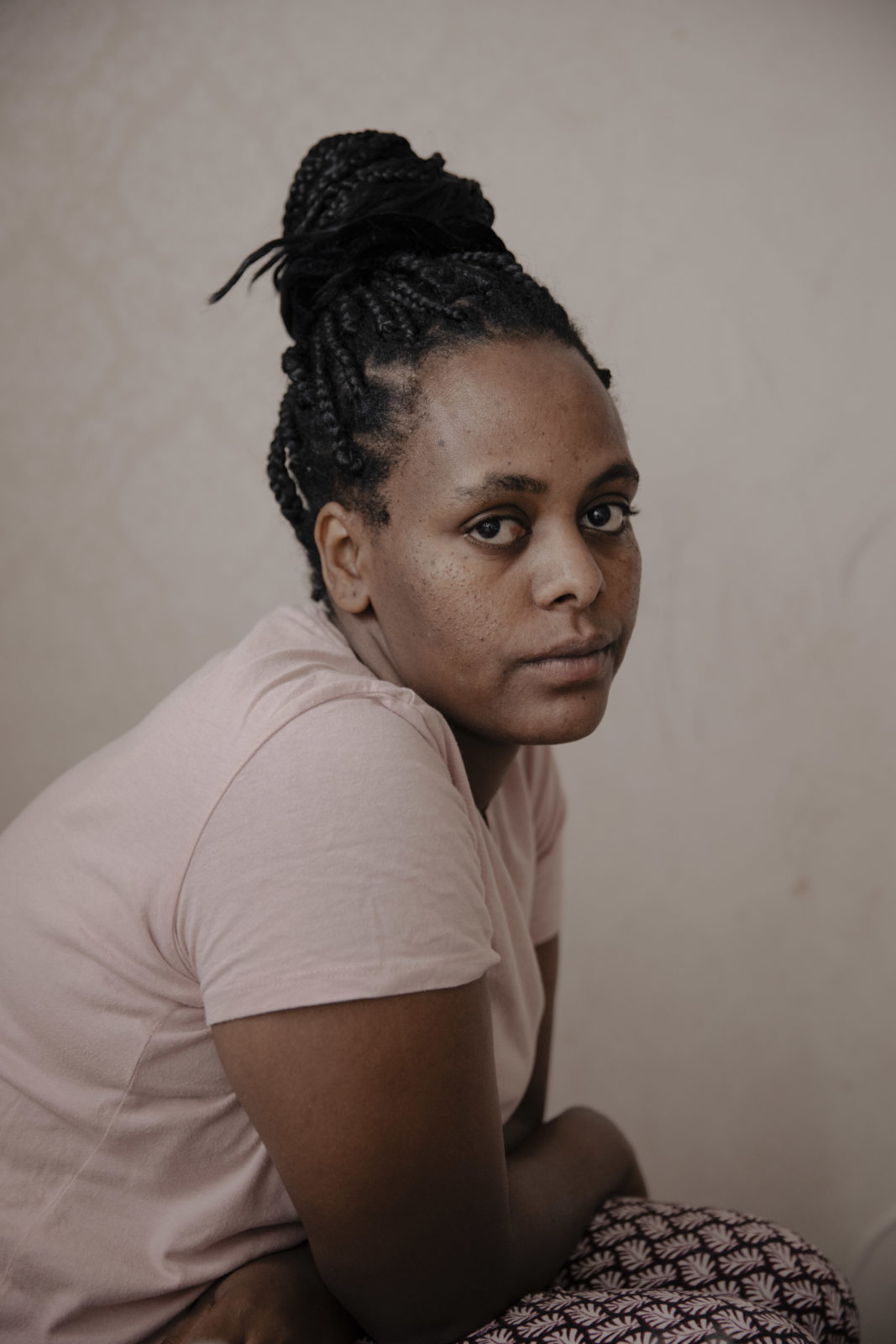
Fanus Okbay from Eritrea was 17 years old when she fell into the sea. She survived. © Helena Lea Manhartsberger für DIE ZEIT
It is just after 7am when the coastguard of Lampedusa raise the alarm. Pietro Bartolo, the island’s doctor, immediately goes to the harbour, as he will later recount. As Lampedusa’s doctor, Bartolo is responsible for the island’s 6,000 or so inhabitants. But in recent weeks he has been concentrating on the people who have been arriving almost daily from North Africa. Now he stands on the quay at dawn, expecting the worst.
Some 7,300 kilometres to the west, in New York City, it is still pitch dark when Cecilia Malmström’s mobile phone rings. The Swedish politician is jolted from her sleep in her room. The caller is the Italian interior minister; he is agitated, almost shouting into the phone, Malmström says today. As EU Commissioner for Home Affairs, she is responsible for European migration policy at that time. The minister says a boat has sunk off Lampedusa, many are dead, all refugees — “It’s terrible!”
Political scientist Gerald Knaus hears about the shipwreck on the news on his way to Sweden. He lives in Paris and advises governments on international policy. He can only guess that migration will soon be one of his main topics.
At the time of the accident, Ousman Sanneh was working as a painter in Gambia, West Africa. He is a young man who left school to look after his family after the death of his father. There is still nothing to suggest that he will one day live across the Sahara in Tunisia and make his living transporting people across the sea to Europe.
On 9 October 2013, six days after the disaster, a political delegation arrived at Lampedusa’s small airport. The group includes Cecilia Malmström, the Italian Minister of the Interior and Prime Minister Enrico Letta, as well as the President of the European Commission, José Manuel Barroso. Some islanders and activists from the mainland were already waiting for them. They held up photos of the drowned and shouted “shame” and “murderers”.
The group entered a hangar at the airport. Inside are three long rows of brown wooden coffins and a few small white coffins with teddy bears on top, the coffins of children who drowned. TV cameras film Barroso looking down and taking a deep breath. Not all the dead have been recovered; in the end there will be 366.
Later, at a press conference, Barroso says he will never forget the sight of the coffins and promises that everything will be done to change the situation in the Mediterranean. “This kind of tragedy that we have seen here, so close to the coast,” he says, “must never happen again.”
Today, 10 years later, we have to admit that it has happened again. In fact, it has happened so often that this kind of tragedy has become part of everyday life in Europe. Thousands of asylum seekers still drown in the Mediterranean every year. In the first nine months of 2023 alone, 2,517 people drowned, the highest number since 2017. Despite all the ideas and strategies, despite all the summits and reform proposals, despite all the declarations of intent and working groups — and despite all the resources that have since been poured into controlling migration.
Why can’t Europe find an answer to the deaths?
Fanus Okbay says she cannot remember the hours after the boat capsized. The rescuers told her that she was clinging to a corpse and had not even managed to grab the lifebuoy thrown to her by the men of the Italian coastguard. One of them jumped into the water to pull her out. There is footage of Okbay waking up in the emergency room on Lampedusa. Next to her, bodies wrapped in gold foil are being pushed through the corridors. Fanus Okbay was one of the 155 people who survived.
The village of Arbrå is a good three hours’ drive north of the Swedish capital, Stockholm, not far from the sea. There is a pizzeria and a supermarket in the centre of the village. It is the summer of 2023 and Fanus Okbay is out in the woods with her children. Her six-year-old son is picking blueberries in a plastic bucket. Her four-year-old daughter is running down to the river. Fanus Okbay says she loves Sweden in the summer. But the winters are dark and cold and hard to bear.
A political divide emerges
After the shipwreck, Okbay was first taken to a reception centre on Lampedusa and later to the Italian mainland. From there she travelled to Sweden because she had heard that many Eritreans lived there. One of them is now her partner. They live with their children in a two-room flat in Arbrå. On the wall of the living room are photos of Fanus Okbay’s new life — her children as babies, and her laughing in a white dress.
Next to them is a collage of dozens of faces, some copied from passports, others snapshots, smiling men and women. They all died in the shipwreck. More than 200 of the dead have not yet been identified. The Mediterranean is also a grave for the nameless.
Another picture on the wall shows a group of young people with Pope Francis in the centre. They are survivors, photographed at the Vatican on 1 October 2014, on their way to Lampedusa. At that time, Fanus Okbay also travelled to the island to commemorate the first anniversary of the disaster; an aid organisation paid for the flight. Pope Francis gave everyone a white plastic rosary. Okbay keeps it in a bag, along with a Bible in Tigrinya, her mother tongue.
These days, in 2023, on the 10th anniversary, she is back on Lampedusa. The survivors gather on the coast, pray and light candles. They go out to sea, to where the ship sank, and scatter flowers in the water. They remember the day that marked a turning point in their lives, but also in Europe’s perception of refugee and migrant movements.
Boats had sunk before: 61 people died in a shipwreck between Turkey and Greece in 2012, the same number in an accident in Libyan waters the year before. But there was no outcry. Then came Lampedusa; 366 dead, just off the coast. It was a shock.
At the time, in early October 2013, Cecilia Malmström was in New York for a United Nations conference — on migration, of all things. On the morning of 3 October, UN Secretary-General Ban Ki Moon stepped up to the marble lectern in the wood-panelled hall. “We only have to look at the headlines this morning to understand the importance of our meeting,” he says. “I offer my deepest condolences.”
After Ban Ki Moon’s speech, many representatives from different countries make short statements of condolence to the press. No one can ignore the issue anymore. Malmström says that something significant was set in motion at that moment.
Six days later, Malmström visited Lampedusa, together with the Italian prime minister and interior minister and the president of the European Commission. The coffins lay in front of them. “It was one of the worst days of my life,” recalls Malmström. To this day, she says, the images have stayed with her.
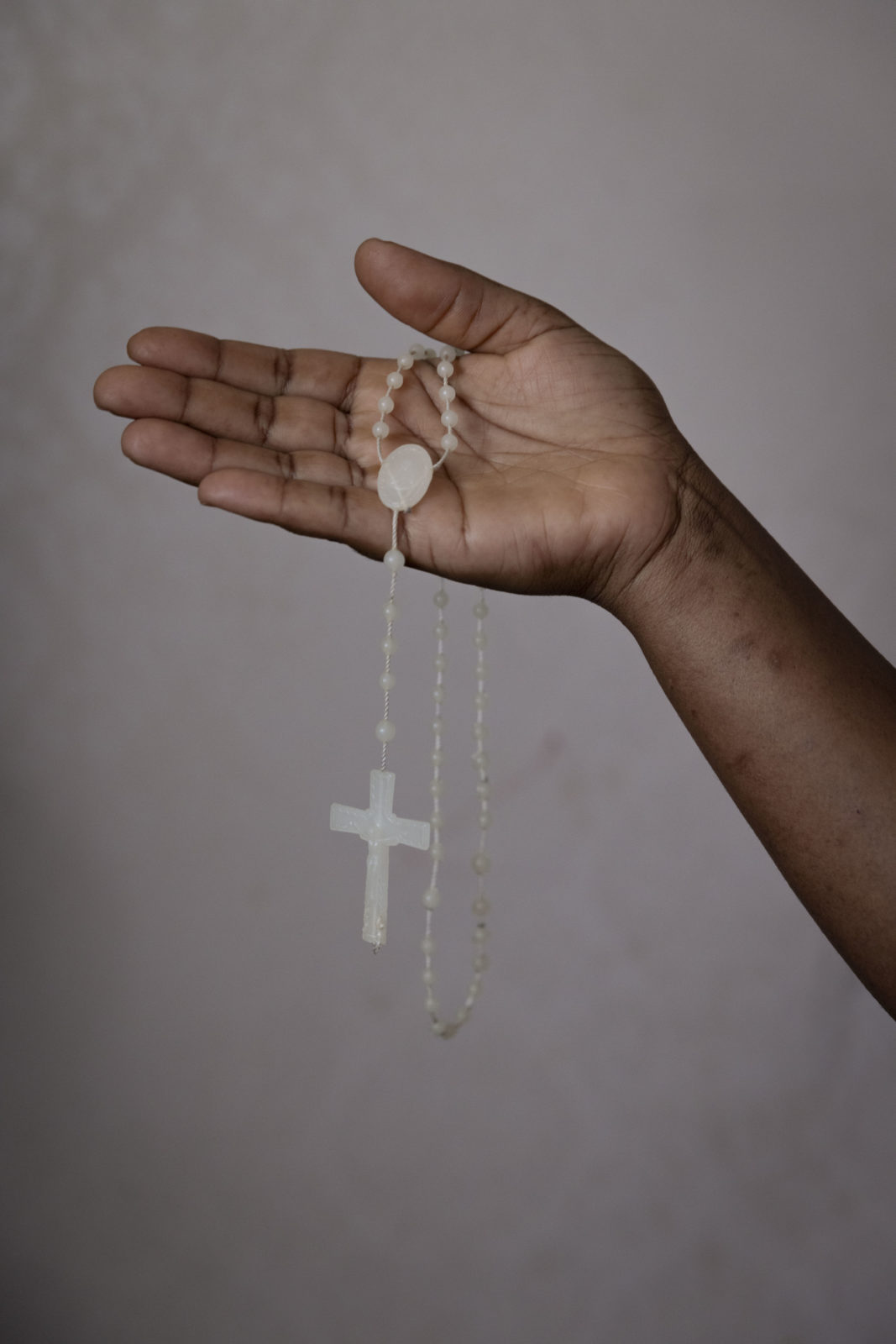
Fanus Okbay holds a white rosary in Sweden, which she received from Pope Francis. © Helena Lea Manhartsberger für DIE ZEIT
Just two days later, on 11 October, another boat sank off the coast of Lampedusa. 268 people died. Malmström says she spoke to the Italian interior minister on the phone every day and barely slept.
Cecilia Malmström, now 55, studied political science. For many years she was a member of the executive committee of the Swedish Liberals, a centre-right party. After the Lampedusa disaster, Malmström developed a strategy consisting of three building blocks. The first was surveillance. The border agency Frontex would collect images from satellites, drones and helicopters, as the route between North Africa and Italy remains a blind spot. Malmström believes that if the sea could be monitored, ships in distress could be located and drownings prevented. Rescue at sea is the second building block.
The third is to allow people to cross the sea safely. Asylum seekers should be able to explain why they need protection while in Africa, and then, if the decision is in their favour, travel to Europe by boat or by plane. They should seek this option rather than fall into the hands of people smugglers. This is called resettlement. But this will only work if individual European countries are prepared to accept refugees.
16 October 2013: Malmström presents her plan to the European Commission. She says she has received a lot of encouragement. The German government also approves of her work, according to Günther Oettinger. At the time, the CDU politician sat on the commission with Malmström; he was responsible for energy and reported regularly to Berlin. He still speaks respectfully of Malmström’s work.
18 October 2013: Italy declares a humanitarian emergency and sends part of its military fleet to Sicily. The operation is called Mare Nostrum — “Our Sea”. From now on, hundreds of rescuers on naval vessels will save people from drowning. Aeroplanes can spot boats in distress from the air. But Italy does not want to wait for the EU and is anticipating the second building block of Malmström’s strategy: anyone in distress in the Mediterranean must be rescued. Human rights organisations welcome the move, but conservative politicians criticise it. A political divide emerges.
19 November 2013: a meeting of EU interior ministers. The British representative accuses the Italians of inviting Africans to Europe with Operation Mare Nostrum, Malmström recounts today, adding that she left the room after this statement.
“Lampedusa became a symbol of political failure”
Malmström made a note in her notebook of an encounter at an EU summit with a representative of the Lithuanian government, whom she refuses to name. He spoke to her and said: “We don’t accept refugees. You can forget it”.
She asked: “Can you at least take a few hundred to set an example?”
The man just shook his head.
Malmström says she wrote the last notebook entry for 2013 on 19 December, after a meeting of interior ministers. It reads: “The ministers have forgotten about the coffins and are only focused on stopping illegal migration.”
Five months later, the European Commission presented a working paper. It contains many concrete proposals: strengthening the border agency Frontex, tougher action against smugglers. Resettlement is only mentioned in passing, and a joint European sea rescue service is barely mentioned.
“We could have used the disaster 10 years ago to find a truly comprehensive, solidarity-based response to the deaths in the Mediterranean,” says Malmström. “But Lampedusa became a symbol of political failure.”
That failure can be measured in numbers. The International Organisation for Migration (IOM) estimates that around 28,000 people have drowned in the Mediterranean since 2014. Or one can look at Lampedusa, where on some days in the late summer of 2023 more people arrived than the island had inhabitants — 120 boats in 24 hours is the latest record. At the end of August, a coastguard vessel anchored in the harbour with 98 rescued people on board. Normally they are dropped off at the quay in a military compound shielded by a brightly painted wall. As there is no more room on the quay, the rescue vessel CP285 is now moored next to the tourist ship Adriana. On the right side of the quay, holidaymakers in bathing suits wait to board for a tour of the island. On the left, 98 men, women and children are huddled together, waiting to go ashore to Europe. They have come by dinghy from Tunisia.
A child on his mother’s lap looks dazed. A pregnant woman holds a bottle of water over her head. The organiser of the boat trip shouts at the coastguard: “Why aren’t these people wearing masks?” He said the tourists had complained that they were afraid.
The next day, Pietro Bartolo, the island’s doctor, now 67, sits on a bench on the quay and says, “This is where they arrived 10 years ago, the survivors and the bodies.” He still remembers the first rescuer to arrive in her boat, a young woman. She had been at sea with friends and they had taken 49 people on board. The woman was crying because she couldn’t save any more.
The second boat had saved 17 people. A friend of Bartolo’s was on board. He said that the people in the water were too slippery from the petrol and slipped out of his hands. It was the first boat to bring four bodies to the quay. The rescuers were packing the bodies into blue plastic bags when Bartolo said he wanted to have another look at the dead. The first three bags contained men, their arms bent as if they were doing chin-ups. Rigor mortis.
Bartolo opened the fourth bag. A teenager, not yet rigid — probably recently dead, or was she? Bartolo grabbed her arm. He thought he felt a faint pulse. Impossible, he told himself, and dismissed it as an illusion. Bartolo waited for more than a minute and then, sure enough, there was a heartbeat. At the hospital, as the doctors pumped seawater out of her lungs, Bartolo watched the girl come back to life. Years later, on the annual day of remembrance, a young woman in her early 20s ran up to him at the airport entrance and hugged him, her saviour.
Today, Bartolo says: “I don’t know why I decided to wait more than a minute. I don’t know, but that’s how it happened.”
Pietro Bartolo was trained to bring children into the world, not to rescue them. He is a gynaecologist who grew up in Lampedusa. He knows what it feels like to almost drown, having fallen overboard from his father’s fishing boat as a boy. In all his years on the quayside, he has learnt to do everything at once: listen to refugees’ lungs, open body bags, and keep in touch with survivors, one of whom he has adopted.
Bartolo is the first to see how the arrivals are doing, and he also notices when something changes. After Operation Mare Nostrum began, he noticed that many people were arriving with serious injuries: assuming they would be rescued anyway, many traffickers put people in cheap rubber dinghies. Inside, petrol from leaking canisters mixes with seawater and corrodes the skin. But years later, Bartolo is still fighting for a government rescue service.
In 2014, the number of crossings continued to rise. By the end of August, 112,000 people had arrived in Italy, five times as many as in the whole of the previous year. By 3 October, the anniversary of the disaster that should never have happened again, the IOM had counted more than 3,000 drowned and missing people for 2014.
7 October 2014: It is announced that funding for Mare Nostrum will run out in three weeks. Italy has been paying the €9.3 million a month for the mission almost single-handedly and feels abandoned by the EU. Other member states have refused to provide financial support. Cecilia Malmström says in a public statement that the Italians have done a “tremendous job”.
But critics of the rescue mission feel vindicated by the large number of boats arriving, including the German Interior Ministry in Berlin. Helmut Teichmann was head of the department for federal police affairs at the time. He says Mare Nostrum was met with scepticism from the start. There were fears that the rescue ships would act as a “pull factor”, encouraging people to attempt the crossing. Teichmann recalls visits to the Italian government in Rome to lobby for an end to the mission.
9 October 2014: EU interior ministers meet in Luxembourg. Germany’s Thomas de Maizière complains: “Mare Nostrum was intended as emergency aid and turned out to be a bridge to Europe.”
1 November 2014: Frontex launches Operation Triton. Planes, helicopters and ships now only patrol the 30 nautical mile zone off the coast of Italy. There is no longer a state rescue mission in international waters. Those who see rescue at sea as a pull factor assume that this change in policy will act as a deterrent and that the number of refugees will fall again — but this will soon prove to be a fallacy.
Why has so little happened since then?
By the end of 2014, Mare Nostrum will be history. But what happens next? “We kept coming back to the idea of working on a common European framework,” recalls Helmut Teichmann. “But that was more talk than concrete action.”
A common European solution. To this day, it remains the most frequently cited utopia in the migration debate — and one of the most popular excuses for political inaction. Perhaps because it is convenient for governments to call for a European solution while accepting as few refugees as possible.
Geneva, September 2023: the late summer sun shines through the glass roof of the World Trade Organisation (WTO) headquarters. Just before 3pm, Cecilia Malmström sends an email: “I’m standing in the atrium and I’m wearing a long pink dress. Where are we meeting?”
Malmström’s political career is over. She now works for an American think-tank on global economic issues. She is due to speak at the WTO in Geneva on trade, climate and sustainability. She suggests we sit on a terrace on the shores of Lake Geneva. She says she used to come here often, including when she was Home Affairs Commissioner, until she left nine years ago to become Trade Commissioner.
Why has so little happened since then?
Because migration is one of the most complex policy areas, Malmström replies. Because it is incredibly difficult to say what should be done. Saving more people from death is, of course, still her view. “But then what?” There are people on the boats who are fleeing in the classic sense of asylum law. But there are also people who are fleeing not from war and oppression, but from poverty and hunger, and who therefore fall outside the scope of asylum law. “Even with the biggest heart in the world, we couldn’t welcome them all to Europe,” says Malmström.
The current EU Commission President, Ursula von der Leyen, recently unveiled a 10-point plan that sounds very familiar. There is talk of “intensifying border surveillance at sea and in the air”, of “combating human trafficking” — but also of “developing alternative offers such as humanitarian admission and legal entry routes”. All this was already set out, in much greater detail, in the working paper that Malmström presented 10 years ago. Ten lost years.
12 April 2015: A boat travelling from Libya to Italy capsizes. An estimated 400 people drown.
18 April 2015: A fishing trawler near the Libyan port of Tripoli sends a distress call to the Italian coastguard. They in turn ask a Portuguese freighter to help the migrants on board. It is night, pitch dark, as the captain will later describe. The ships collide, and the trawler sinks with more than 800 people on board, only 28 of whom survive. Europe is shocked again.
23 April 2015: The new President of the EU Commission, Jean-Claude Juncker, addresses the European Parliament in Strasbourg. He says: “The Mare Nostrum mission was a serious mistake. It cost human lives.” Juncker calls for the rescue area of Operation Triton to be extended. The member states that previously blocked this agree, including Germany. Naval fleets with a capacity similar to that of Mare Nostrum are deployed, only this time in the name of the EU.
A hope that was not fulfilled by the EU-Turkey pact
Resettlement programmes were once the third building block of Cecilia Malmström’s migration strategy. What the United Nations was doing on a small scale, she wanted to do on a larger scale across Europe: people should not have to risk their lives to seek asylum. At first, this did not seem unrealistic. But with the rise of right-wing populists, the mood in Europe has changed. First there was Viktor Orbán in Hungary and the PiS in Poland, then the Lega Nord in Italy and the FPÖ in Austria. Right-wing populists are now in power in Finland, the Danish Social Democrats are also focusing on deterrence, and in the Netherlands the coalition government fell apart in a dispute over a stricter migration policy. In Italy, the post-fascist Giorgia Meloni is in power, while in Greece the blatant human rights violations at the EU’s external border, for which the conservative government is responsible, are hardly a political issue.
And in Germany? “We will reduce irregular migration and facilitate regular migration,” the parties of the traffic light coalition wrote in their agreement. That was two years ago. It has still not been achieved.
In practice, the only political measure that at least comes close to the principle of resettlement, even if it has never worked as intended, is a pact concluded in Brussels on 18 March 2016: the EU-Turkey Statement.
It states that the EU will accept Syrian refugees from Turkey through resettlement. It will also pay the government in Ankara billions of euros to look after the Syrians. In return, it can send back to Turkey any Syrian who arrives in Greece outside the resettlement programme.
Seven years later, the man considered the architect of the pact is sitting in a beach bar on the Atlantic. He is in Santander, in the north of Spain, surrounded by high waves, white beaches and grassy cliffs. It is already dark, and the next morning Gerald Knaus will share a podium with the Senegalese foreign minister. “Quo Vadis Europe?” is the title of the conference.
On stage, Knaus intends to make a proposal to the minister that applies the idea of the Turkey agreement to another escape route: Senegal should take back its citizens who cross the Atlantic to the Canary Islands. In return, the country could receive scholarship programmes for young Senegalese, a quota for migrant workers and easier access to Schengen visas.
Knaus heads the European Stability Initiative, a non-profit organisation funded by political foundations and European governments. He is 53 and from Austria. He founded the organisation in 1999 with friends in Sarajevo, Bosnia, in the aftermath of the Balkan wars. Their work involves developing and disseminating geopolitical strategies, visiting ministries and advising politicians. If all goes well, a government will take up their ideas.
Knaus has 15 minutes at the podium to present his proposal. “It is worth a try,” he says.
Why Senegal of all places? Why a country that hardly plays a role in the deadliest refugee route, the central Mediterranean?
Knaus says politicians need to prove that there is a way to manage migration in a humane way. If this works, it might one day be possible to use a similar principle to prevent people from taking the central Mediterranean route — and those who are genuinely entitled to asylum could be resettled in Europe.
It is a hope that was not fulfilled by the EU-Turkey pact: only 38,000 Syrians have made it to Europe through resettlement. Critics argue that the EU is outsourcing its responsibility to an autocratic regime, a country where refugees have to live permanently in huge container camps. Ever since Turkish President Recep Tayyip Erdoğan opened the borders to Bulgaria and Greece in March 2020, while demanding concessions in the Syrian war, the pact has been seen as a failure.
However, anyone looking at the sharp drop in the number of arrivals can see it as a success, with fewer refugees actually crossing the sea. What’s more, while more than 1,100 people died in the Aegean in the 12 months before the deal, fewer than 100 died in the 12 months after.
And in the central Mediterranean? In 2016, three years after the 3 October disaster, more people were rescued there than ever before. But more people died than ever before: 4,581.
Approaches to migration agreements fall broadly into two categories. The first, which has rarely been implemented, is to facilitate legal migration and deport those who do not enter through the designated routes, as in the case of the EU-Turkey statement. The second category is simply to reduce migration. In other words, to pay states to stop people.
In November 2014 — and with this in mind — EU foreign and interior ministers meet with representatives of African countries in Rome. Together they announce the launch of the Khartoum Process, named after the capital of Sudan. Despite the existence of an arrest warrant issued by the International Criminal Court against the then president, Omar al-Bashir, accusing him of genocide, this doesn’t prevent the EU states from negotiating with him. They now want to work with countries of origin and transit along the routes from East Africa to Europe.
In 2015, Helmut Teichmann made two trips to Cairo, where a military regime had taken power. The German official had a proposal: a repatriation agreement. Egypt could take back migrants crossing the Mediterranean to Italy. Teichmann also had a region in mind — between the densely populated Nile Delta and the Libyan border there are hundreds of kilometres of almost undeveloped land. Perhaps reception centres could be set up there, where people could go through the asylum process. Then, if they are in need of protection, they could be distributed around Europe. The idea was similar to the pact with Turkey that was agreed shortly afterwards.
Unfortunately, Teichmann had nothing to offer in return — a few thousand study visas for young Egyptians or a few million euros for the army. He says he didn’t have anything concrete: “I failed miserably.”
The theory that rescue at sea encourages people to make the crossing
Cecilia Malmström says she always found the concept unrealistic. What would happen to the people in these camps if no European state took them in? Would they be stuck in countries where human rights are even less respected than in overcrowded camps on Greek islands?
Another attempt was made at the end of 2016. The same idea — asylum procedures in reception centres, this time in Tunisia. Teichmann promoted the plan in Italy and at the EU Commission, but once again nothing came of it. The country with which the EU would sign a migration pact seven years later was seen as a beacon of hope, the only democracy left over from the Arab Spring.
As is often the case in Europe when it comes to migration, each country tries to find its own solutions. And in this case, Italy would rather work with Libya than Tunisia.
friLess than two months later, in February 2017, a joint memorandum of understanding is signed: the Libyan coastguard will stop migrants and will be supported with tens of millions of euros. In contrast to the German strategy for Tunisia, no resettlement is planned. The fact that asylum seekers in Libya are locked up in camps and tortured, that in this country torn by civil war it is often difficult to distinguish between militias, people smugglers and the coastguard, and that boats are forced to turn back by force of arms, will be reported again and again in the years to come. Nevertheless, the Italian government is prepared to use Libyan support to ensure that fewer people make it across the Mediterranean. And indeed, when the agreement comes into force, the number of arrivals in Italy plummets.
1 June 2018: A new government is formed in Italy. The populist Five Star Movement forms a coalition with the right-wing nationalist Northern League, the Lega Nord.
31 March 2019: Operation Sophia withdraws all ships and continues only with aircraft. The rescue mission becomes a surveillance mission. (…)
12 June 2019: The civilian rescue ship Sea-Watch 3 takes 53 people in distress on board, but Italy refuses to allow it to enter the country. (…)
There it is again: the theory that rescue at sea encourages people to make the crossing. There is still no scientific proof of this. A study published in the prestigious journal Nature in August 2023 clearly contradicts this theory: rescues at sea have no demonstrable effect on migratory movements. What matters is the situation in the countries of origin — poverty, war, climate change.
Back in Santander, Spain, Gerald Knaus has taken his place on the stage. Next to him is Josep Borrell, who has been organising the annual conference for more than two decades, first as a university professor and now as the EU’s foreign policy chief. Also present are an expert on the Canary Islands and Senegal’s Foreign Minister, Aïssata Tall Sall.
Knaus presents his idea. He says things like, “It could completely change the debate on migration,” or, “There is an alternative. Let’s try it.” The foreign minister nods. When Knaus finishes, she claps and shakes his hand. As the Canary Islands expert speaks, the two whisper and exchange business cards.
8 June 2023: In Luxembourg, EU interior ministers agree to reform the Common European Asylum System. (…)
14 June 2023: A boat carrying up to 750 people sinks off the coast of Greece. Only 104 survive. It is the worst maritime disaster since 2015. Investigations by international media show that the trawler was spotted early on by Frontex planes, but the Greek coastguard did not come to the rescue — in other words, it was monitored but not rescued.
16 July 2023: Ursula von der Leyen travels to Tunis with Italian Prime Minister Meloni and Dutch Prime Minister Mark Rutte. The EU and Tunisia announce a Memorandum of Understanding: Tunisia will crack down on smugglers and the coastguard will stop boats. In return, the EU promises mainly economic aid. There is also talk of legal migration, but no concrete plan. At the same time, news is spreading that the Tunisian authorities have abandoned hundreds of migrants in the desert. A devastating photograph goes viral: a woman from the Ivory Coast lying face down in the sand, her six-year-old daughter beside her, having tragically succumbed to thirst.
A few hundred kilometres away, in the north of the country, in a restaurant from the heyday of Tunisian mass tourism, faded curtains block the view of the sea. Ousman Sanneh feels safe here, even though he stands out: a muscular man in a sleeveless shirt, shorts and new trainers. Sanneh says his job has become much harder since the EU and Tunisia reached an agreement. The police are looking for him and there are more and more raids. So he has moved on from Sfax, the Tunisian port from which most of the boats to Lampedusa leave, to the north, where he now sits every evening in this smoky café.
Ousman Sanneh is 34 years old, his real name is different and his exact whereabouts cannot be disclosed. Sanneh is a people smuggler. He says he helps his clients cross the sea. Sanneh is from Gambia in West Africa. He has been in Tunisia for just under a year, putting migrants on boats, or so he says. His story cannot be verified in detail, but it is consistent with what is known about the smuggling business in Tunisia.
The investigation was supported by journaFONDS.
The Pylos Shipwreck
In the early hours of June 14, the state-of-the-art cameras of the Coast Guard vessel ΠΠΛΣ-920 were off.
The deadliest shipwreck within the Greek Search and Rescue Zone, one of the largest the Mediterranean has ever seen, was reportedly not visually detected.
Only hours before, aerial photos of the overloaded fishing vessel were taken. Nearby tankers recorded videos before they were ordered to leave the scene. There were satellite images that captured its movement.
But the exact circumstances in which the Adriana capsized off Pylos, killing more than 600 people, remain unclear three weeks on.
In affidavits and interviews, some of the 104 survivors attributed the sinking of the fishing vessel to an attempt by the Hellenic Coast Guard to tow it to Italian waters.
The Coast Guard emphasizes that it saved human lives, and maintains that the fishing vessel overturned due to a disturbance by the passengers.
Solomon, in a joint investigation with the research group Forensis, The Guardian and German public broadcaster ARD reveals: the Coast Guard vessel ΠΠΛΣ-920, the only vessel present at the time the Adriana capsized, was obligated to “document its operation by video-recording” in accordance with a 2021 Frontex document which recommends that the Greek authorities record their operations continually.
If this had been done, today there would be answers to the questions that the victims’ families are still asking.
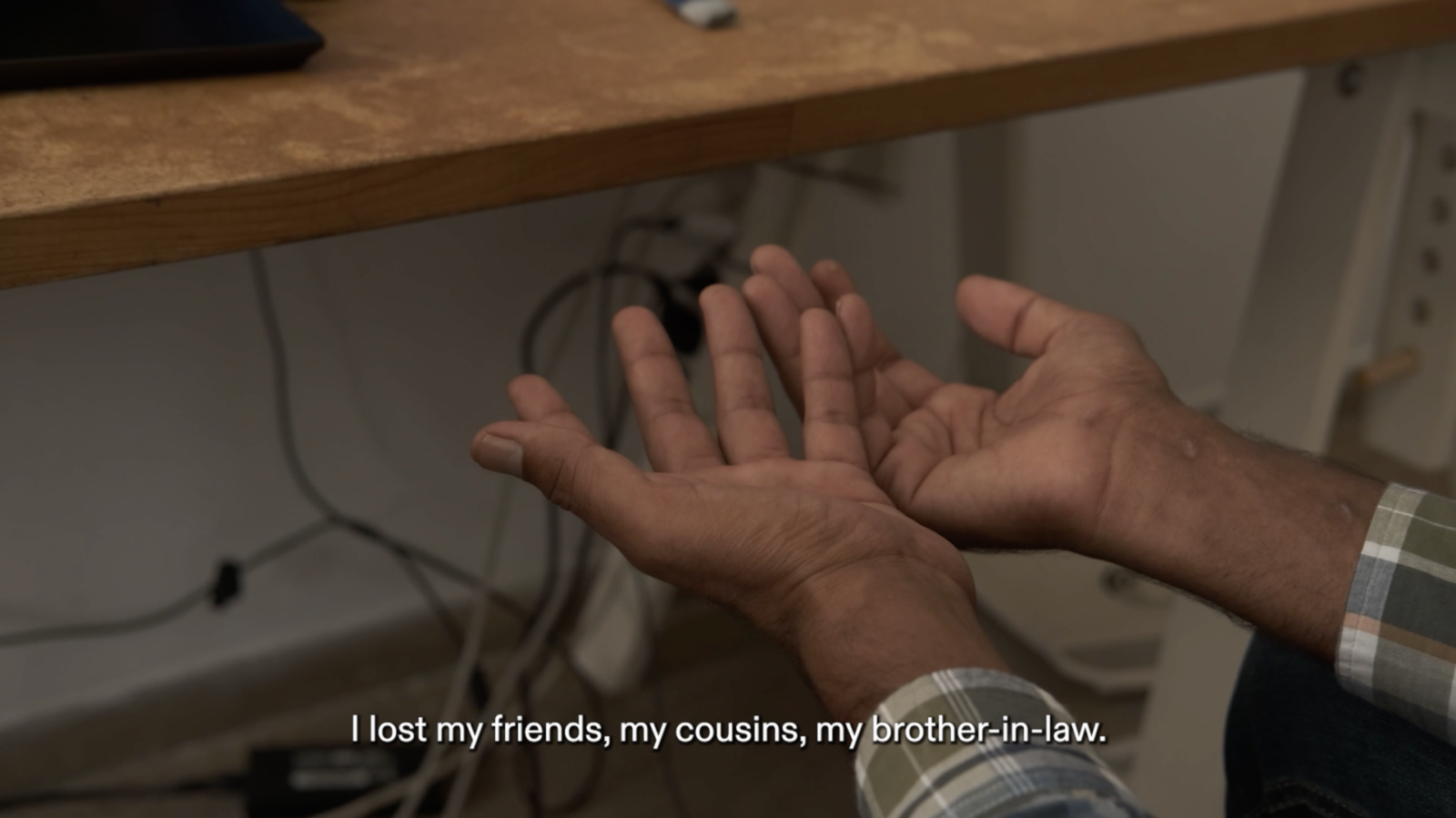
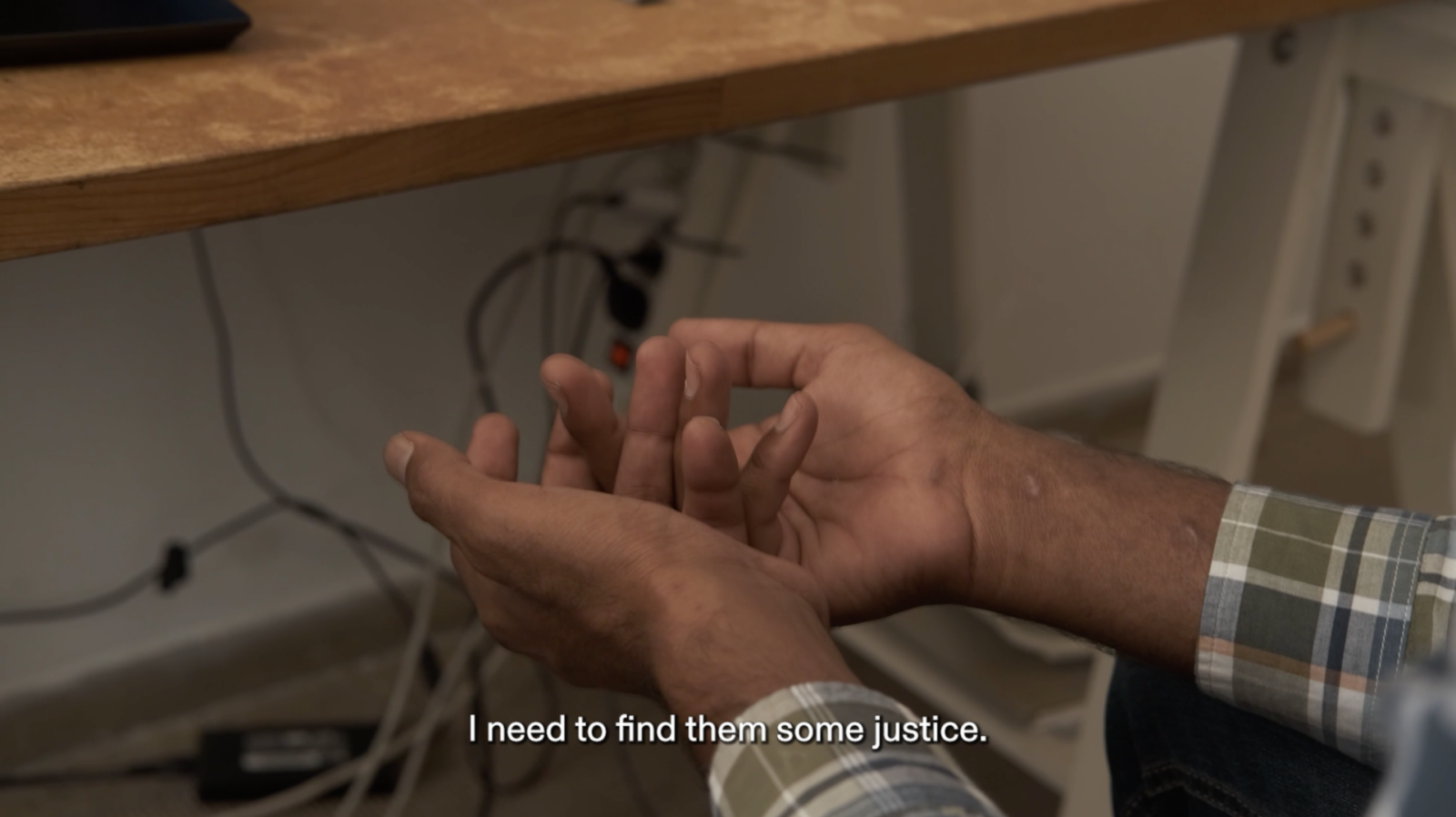
The ΠΠΛΣ-920 cameras were supposed to record
By midday on June 13, the Greek and Italian authorities and Frontex (the European Border and Coast Guard Agency), were aware of the overloaded fishing vessel, which had been sailing aimlessly for four days in the central Mediterranean – its only means of navigation was a compass and the position of the sun.
The activist network Alarm Phone had also relayed to the authorities the desperate SOS of some 750 men, women, and children — mostly from Pakistan, Egypt and Syria — who, lacking potable water, were using their shoelaces to lower containers into the sea: “They are urgently asking for help”.
ΠΠΛΣ-920, the Coast Guard vessel which received the order to depart from the port of Souda, Crete to assist, has been the pride of the Coast Guard since 2021. European funding covered 90% of its cost, and it is one of the best-equipped vessels available in Greece.
And it could not be in better hands: earlier this year, in March, its captain was awarded for “his valuable contribution to the protection of maritime borders and human life at sea.”
According to the Coast Guard, ΠΠΛΣ-920, like its three sister ships (ΠΠΛΣ-900, ΠΠΛΣ-910 and ΠΠΛΣ-930), has two state-of-the-art thermal camera systems. According to the Coast Guard, however, when the fishing vessel capsized, the cameras were not in operation because the crew’s attention was focused on the rescue efforts.
“When we have an incident, we try to have the ability to operate seamlessly. Making some crew members ‘inactive’ so that they can record a video, you understand, is unethical,” Coast Guard spokesman Nikos Alexiou stated on June 15, justifying why the incident was not recorded on video.
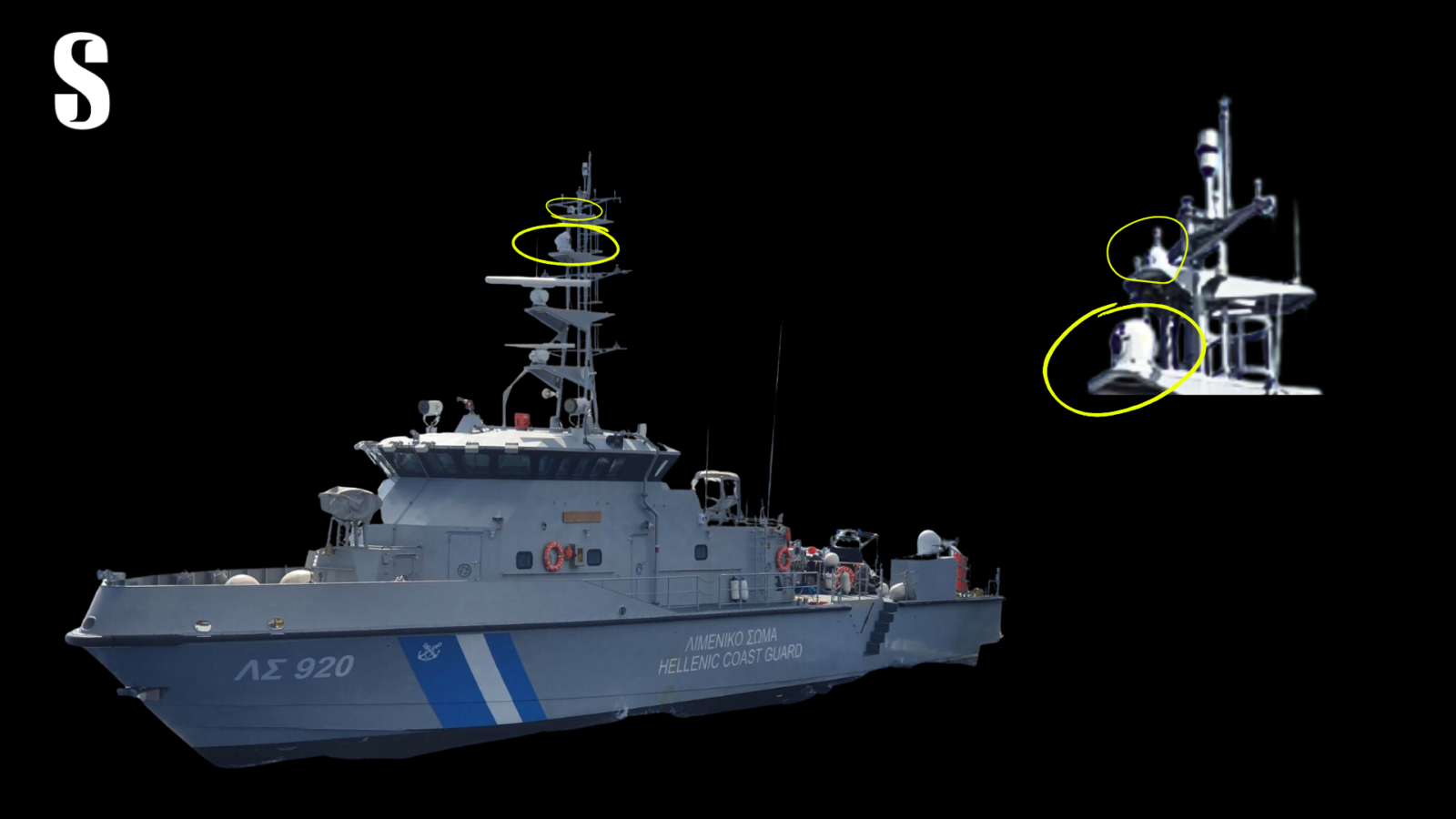
ΠΠΛΣ-920 is equipped with two state-of-the-art thermal cameras.
However, one of the three former and current Coast Guard officers who spoke to us during our investigation, said that these cameras do not require constant manual operation and they exist exactly for this reason – to record such incidents.
But there is still a critical issue: a document reveals that, according to Frontex recommendations in March 2021, the Coast Guard vessel was obligated to record the operation.
The document states that “if feasible, all actions taken by Frontex assets or Frontex co-financed assets… should be documented by video consistently.”
The cost of the ΠΠΛΣ-920, one of four state-of-the-art vessels purchased for €55.5 million, has been 90% financed through Frontex. It is designated to be “available for four months a year, for Frontex missions outside of Greek waters.”
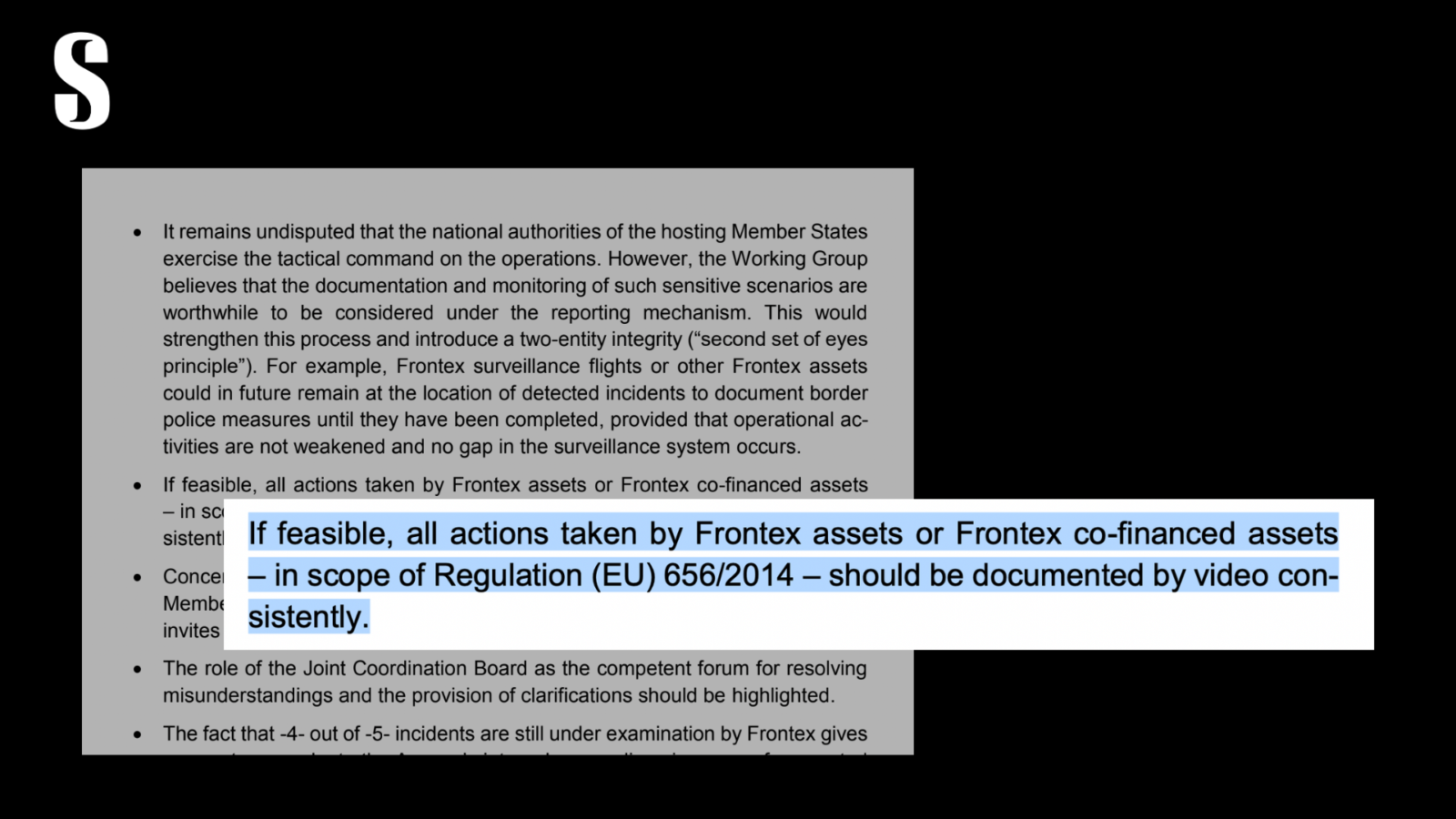
In March 2021, Frontex calls for the Coast Guard vessels funded by the organisation to video record their operations.
Frontex had recommended the visual recording of operations, during a meeting where representatives from Greece were present as well as from other European countries, following complaints of human rights violations by the Coast Guard.
The complaints that were assessed during the meeting referred to the exact same practice, attributed to ΠΠΛΣ-920: towing vessels of asylum seekers outside of Greek waters.
We created a 3D model of the Adriana
Solomon, Forensis, The Guardian and ARD worked together and after analyzing a wealth of evidence, we present the most complete picture to date, of the Adriana’s course up to the time of its sinking.
We collected more than 20 survivor accounts and analyzed material derived from, among others, witness statements, official reports from the Coast Guard and Frontex, deck logs of the Coast Guard vessel and tankers in transit, aerial photographs and data on the position and movement of ships and aircraft. We also secured exclusive footage from the commercial vessels that were in the area and spoke to sources at Frontex, the Coast Guard, and rescuers.
The analysis of this information resulted in a detailed chronology of the events that occurred on June 13 and 14, an interactive map showing Adriana‘s movement, as well as a 3D model of the fishing vessel.
With the help of the 3D model, we were able to do what no official authority or journalistic investigation has done so far: to conduct in-person interviews with survivors of the wreck, using the visual impression of this body of data.
Trawler by Forensis on Sketchfab
Using the method of situated testimony, the survivors placed themselves in the 3D model of the ship, indicated their location on the deck, and recalled the events that unfolded before the sinking of the Adriana: from the alleged towing to its capsize.
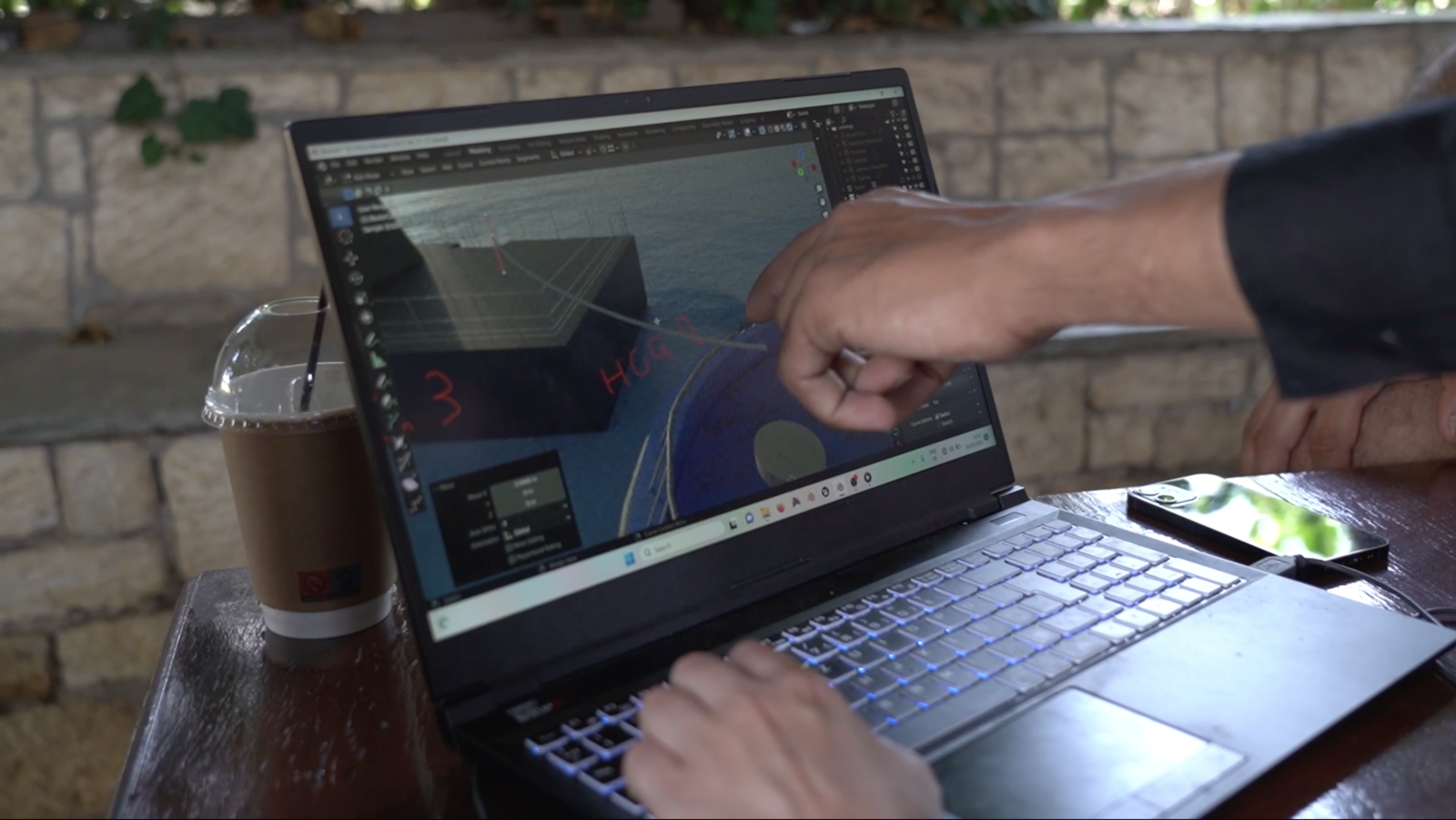
A survivor, using the 3D model, points to the blue rope which was used to tow the Adriana.
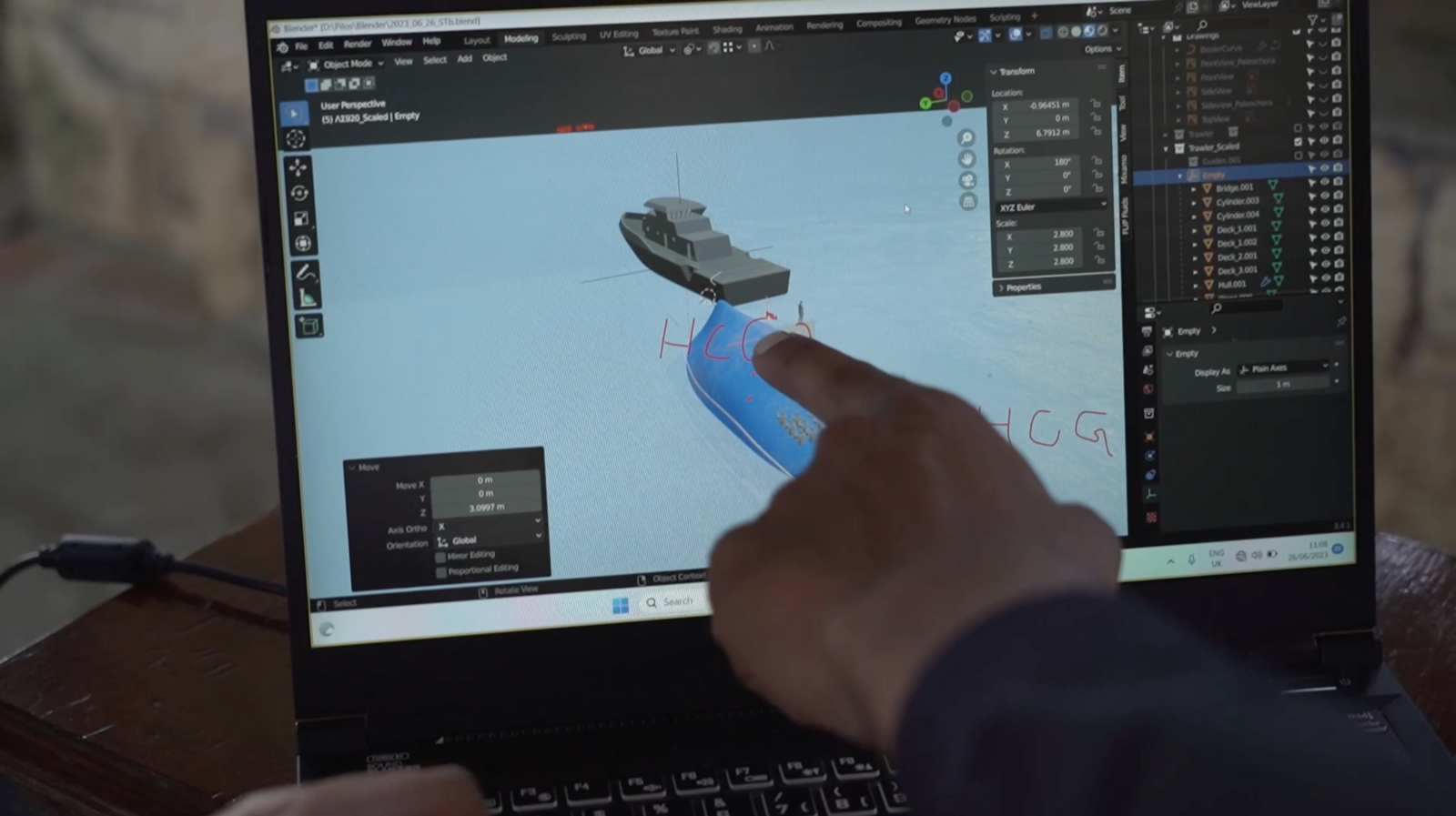
A survivor uses the 3D model to describe how the fishing vessel overturned.
In this way, we were able to cross-reference accounts of what happened in the presence of the Coast Guard vessel, based on each person’s eyewitness account.
Main conclusions
Eleven critical findings emerge from the joint investigation:
- Frontex offered to help three times. A Frontex source stated that the Coast Guard did not respond to any of the three requests for assistance.
- The records of ΠΠΛΣ-920 are incoherent and raise questions. For example, while it is reported that immediately before the sinking, the fishing vessel was moving west, it actually appears to be moving for about an hour (00:44 – 01:40) in a southerly direction at a speed of only 0.6 knots.
- While the fishing vessel’s engine was running but there was no navigation capability, according to testimonies, ΠΠΛΣ-920 approached the vessel and gave directions to Italy. A survivor stated: “[a crew member] told us that the Greek ship would go ahead of us and lead us to Italian waters. He told us that in two hours we would be in Italy.” ΠΠΛΣ-920 directed the fishing vessel from a distance, which followed until its engine broke down again.
- According to Syrian survivors on deck, when the engine broke down, masked men from ΠΠΛΣ-920 boarded the fishing vessel and tied a blue rope to the stern. The above-mentioned testimonies are also consistent with an entry in the ΠΠΛΣ-920 deck logbook, which mentions the participation of a four-member team from the Special Missions Unit in the operation.
- According to the same survivors, there were two brief attempts to tow the fishing vessel. The first time the rope broke. The second time the ΠΠΛΣ-920 increased its speed and the fishing vessel rocked to the right, then to the left, then to the right again and flipped onto its right side.
- The Pakistani survivors were located in the interior of the ship, and could not see what was happening. They stated, however, that while the fishing vessel’s engine was not working, they felt a sharp forward thrust “like a rocket” — a sensation that corroborates the use of a rope for towing.
- Testimonies in this investigation support testaments presented by other journalistic investigations, as well as survivor statements included in the official case file: this action appears to have led to the capsize and eventual sinking of the ship.
- The fishing vessel capsized and survivors climbed on top of it. ΠΠΛΣ-920 left the scene, creating waves that made it more difficult for the survivors to stay afloat.
- After withdrawing, ΠΠΛΣ-920 directed its floodlights on the shipwreck site. Survivors tried to swim to the Coast Guard vessel, but the distance was too great.
- ΠΠΛΣ-920 began the rescue operation 30 minutes after the sinking, and only after the fishing vessel had completely disappeared from the water’s surface.
- Survivors claim that their phones (which were protected in plastic cases) contain visual material from the incident. Immediately after the rescue, according to the same testimonies, Coast Guard officers confiscated their phones, which have not been returned to them.
Survivor accounts of the towing
In the deck log of ΠΠΛΣ-920, which we have seen, there is no mention of any towing attempt. The Coast Guard captain reports that they approached the fishing vessel to offer assistance, received no response, and followed it “from a discreet distance”.
This is disputed by the accounts of the survivors, some of whom not only tell of a rope that was tied to the fishing vessel, but they all mention its color: blue.
This investigation documents, for the first time, the blue cable that was used by ΠΠΛΣ-920, which can also be seen in earlier photos of the vessel.
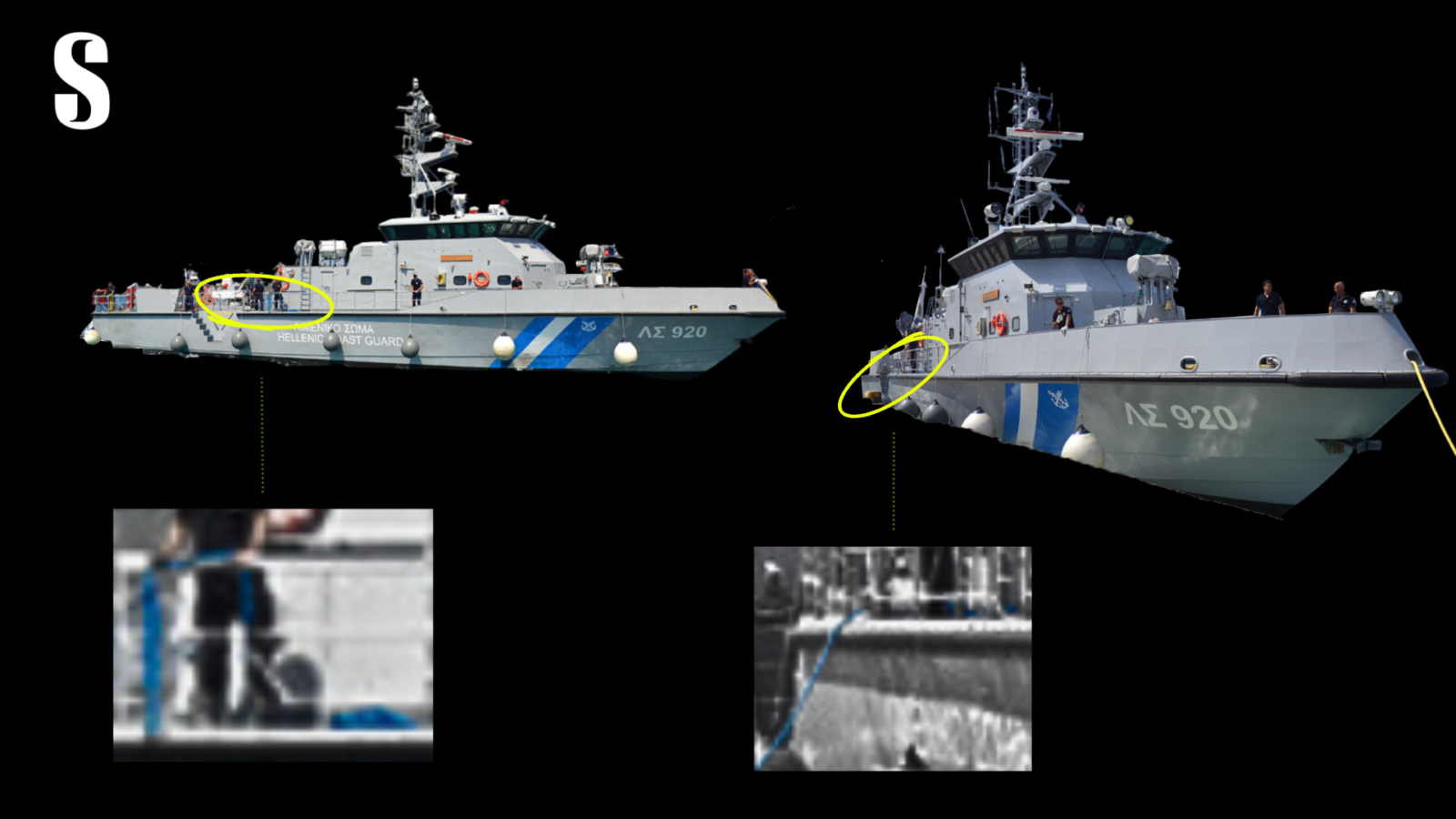
The estimation that the attempt to tow the fishing vessel by the ΠΠΛΣ-920 led to its sinking is underlined by the statements of survivors, that form part of the case file which is available to the journalists that participated in this investigation.
“Then the Greek ship came and threw the rope which was tied to the front of our ship,” says a survivor who was on the deck.
The Coast Guard started towing the fishing vessel, he adds, and “when it was going slowly the fishing vessel was fine, but instead of approaching the Greek ship we were moving away. When they hit the gas, I’m sorry to say, that’s when our ship sank.”
The same survivor estimates that the fishing boat capsized due to the “pulling from the Greek ship, because then our ship began to lean to one side. And I, who was standing in a corner, slipped into the water with a relative of mine, who died.”
Another survivor who was also on the deck, but at the stern and without full visibility, says in his testimony that “it was night, the guys in front told me that they tied the rope, but I could feel the motion too, because then we moved, but not for more than two minutes.”
“Then we said stop-stop because our ship is leaning,” he says, adding, “I think we sank due to the fact that our boat was in bad condition and overloaded and that it shouldn’t have been towed.”
In another testimony, the description of the towing attempt is concise: “On the last day the Greek ship threw us a rope and tied us to their ship. The Greek one turned right, then ours overturned and we fell into the water.”
We contacted the Coast Guard, asking questions about the timeline of the shipwreck and asking them to comment on the findings of our investigation. At the time of publication, we have not received a response.
Why didn’t Greece respond to Frontex?
The picture of what actually happened would be more complete if the ΠΠΛΣ-920 was not the only vessel present during the incident.
According to the captain of the merchant ship Faithful Warrior, at 00:18 the Coast Guard’s Search & Rescue Coordination Center gave him permission to depart the scene, thus removing the last witness present. The Faithful Warriorleft at 00:30, about 15 minutes before the fishing vessel’s engine stopped working, according to Coast Guard records.
Frontex, which operates in the central Mediterranean, had informed the Greek authorities about the fishing vessel early in the afternoon, and had offered to help.
Specifically, at 19:35 (local Greek time) Frontex offered to assist with the Eagle I aircraft. Afterwards, the Greek side asked Frontex to assist in a search and rescue incident south of Crete, where 80 people were in danger. The vessel in question was spotted by the Frontex Heron drone at 22:50.
At 00:34, Frontex again offered to provide assistance with the Eagle I and a few minutes later, at 00:52, it also offered the Heron. According to a Frontex source who spoke to our joint investigation, the Greek authorities did not respond to any request to send aerial assets to the overloaded fishing vessel.
Fabricated testimonies
Concerns have also been raised about the possible alteration of survivors’ testimonies.
Survivors gave two rounds of statements: first to the Coast Guard and then to an investigator. Both versions are available to Solomon and the international colleagues who participated in this investigation.
While there are no references to the attempted towing of the fishing vessel in the survivor testimonies recorded by the Coast Guard, the same survivors spoke about it in the second interview with the investigator.
Also, when describing the shipwreck, the testimonies that appear to have been given to the Coast Guard by two survivors of different nationalities, are the same, word for word: “There were too many people in the boat, which was old and rusty … that’s why it capsized and sank in the end.”
Inside the hold
The TikTok video shows his older brother hugging him tightly and kissing him, before he enters the airport, dragging along his suitcase.
He had flown from Karachi to Dubai, and from Dubai to Alexandria, Egypt. From there he boarded another plane that took him to Benghazi, Libya, where he spent over ten days locked in a trafficker’s hideout, before he was taken to board the Adriana.
When he saw the old fishing boat he couldn’t believe it — he thought the trip to Italy would also be by plane. He wanted to go back to Pakistan, but the traffickers wouldn’t let him.
Inside the Adriana, Abdul traveled on the lowest of three levels, in suffocating conditions where he had to sit with his knees bent. “To get from one place to another, you had to step on people.”
Conditions were similar on the middle level, where about 300 people were reportedly crammed in, with more than 200 people still on deck. The testimonies speak of another, separate space inside the fishing vessel, where women and children were located. No women were among the 104 people that were rescued.
The Pakistani travellers had paid a total of €8,000-€10,000 each for the long journey to Europe – Abdul’s family of rice farmers had sold their land to finance his trip.
Abdul had learned to swim in the canals around his family’s crops – when the Adriana sank, it was his ability to swim that allowed Abdul to reach the Coast Guard vessel and save himself.
As he walks along in Athens, Abdul’s relatives call him, asking what’s the name of the city he’s in. He tells us about his family, but he also shows us photos of loved ones who perished: he was onboard the Adriana with 14 of his friends and his uncle. Only he survived.
And of his 350 fellow Pakistanis who were also in the hold with him, only 12 were rescued. “Beautiful people were lost,” says Abdul.

